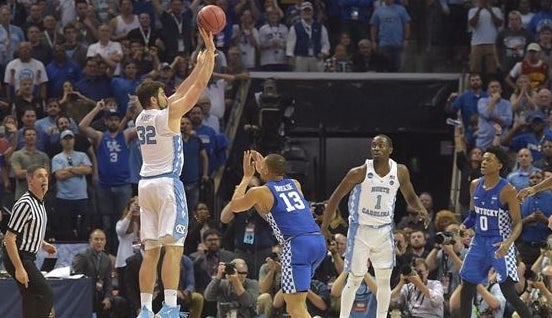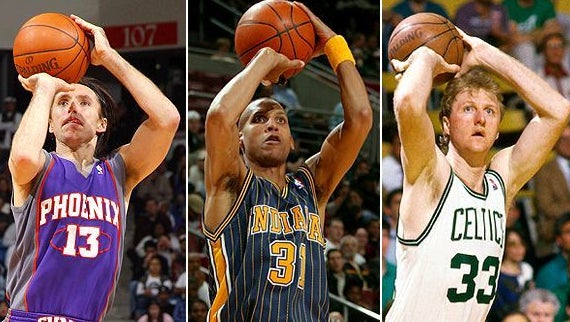
Much has been written about the evolution of basketball as the three point shot has become the cornerstone of offenses at all levels of the game. Many bright executives, coaches and players have embraced the notion of efficiency and have realized that shooting 33 percent from three is the same as shooting 50 percent from two.
Quite literally everyone in the sport now understands that a shot taken from one foot inside the arc is roughly as likely to go in as a shot taken from one foot behind the arc and therefore the reward of stepping back slightly is more than worth the added risk. All of this is taken as gospel truth at this point and this Tournament it seems that NCAA players are starting to become almost as three point happy as their NBA brethren. So if everyone has figured out that an uncontested three-pointer is statistically the best shot possible, and a revolution has occurred on the offensive side of the ball — why haven’t any NCAA coaches changed their defensive philosophies to reflect this newfound reality?
Most specifically, why do players still put forth maximum effort into over-helping and wildly rotating on opponents driving for two point shots and leave their man wide open to shoot threes? Why hasn’t this now innate understanding of the power of the three-point shot on offense changed the defensive coaching philosophies deployed in college basketball? And most importantly — why is the score and time remaining in the game not being taken into account when college coaches are setting up their 3 point defense?

Everyone remembers the game winner. Kentucky and North Carolina played a classic game and because of Luke Maye’s heroics many other important and exciting moments will fade away over time. While Malik Monk’s incredibly clutch and highly contested three to tie the game with 10 seconds left would have received the headlines had Kentucky won, De’Aaron Fox’s shot to take the game from a seven point deficit to a four point deficit is what interests me more.
With 49 seconds left UNC was leading by seven points. Kentucky had the ball and were in desperate need of a quick score. UNC at this point has a win probability north of 95% and simple math tells us that for Kentucky to win the game they will need to make four two-point field goals. Getting four possessions and having UNC not score a single point in just 49 seconds is virtually impossible.
As Isiah Briscoe blows by his man and attacks the rim, instinctively North Carolina’s defense springs into action. There is no awareness at all of the situation by any of the defenders, they simply do as they have been taught and ‘help’ their beaten teammate. They all seem oblivious in the moment to the fact that an uncontested layup barely hurts their win probability. Watching the clip it’s as if UNC’s entire basketball apparatus have no idea that selling out to stop this layup at the expense of leaving an three point shooter open is quite literally the worst thing they could do.
Just by hitting one three pointer, the math changes dramatically. Fox buries the open three after his man leaves him to help on the drive. Had they gave up a wide open layup, UNC would now have the ball and a three-possession lead (assuming they will only concede two-point shots, which is of course the entire premise of this article). Instead, Kentucky has now made it a more manageable two possession game. A two possession game means one turnover. A two possession game means one missed free throw. A two possession game means momentum and hope.
Situations like this have played out across college basketball all season long. In Arizona’s Sweet Sixteen loss to Xavier, the Wildcats were up by seven points with two minutes and forty seconds remaining. While that seems like a lot of time, with a 30 seconds shot clock to work with, the game only has a very finite number of possessions left in it.
Xavier is in a position where getting the most points per their dwindling number of possessions is more important than ever. All the players on the floor know this and yet Arizona continues to play a pack-line defense which is created to stifle potential drives to the basket and encourage three-point shots. When you are 10 minutes into a game this mentality might make sense. However, yet again there seemed to be no situational awareness of any kind from the Arizona coaching staff or their players as to why giving up an open look from three was by far the worst possible outcome. As you can probably guess, Xavier hit an open three-point shot against Arizona’s aggressively helping defense and from there the comeback was on.

These guys must wish they played in this era so, so badly
To get a deeper look from the inside at this peculiar phenomenon I asked a current D1 Assistant Coach for his candid thoughts which he provided in exchange for anonymity.
“Because of how much people understand analytics today, offense revolves around three-point shooting and finishing at the rim,” the coach told me. “However, defensively kids are taught from a very early age to force their opponent to shoot from the outside rather than giving up shots closer to the hoop. This defensive behavior is drilled in through constant repetition at a young age but when teaching these principles, coaches usually forget the all important caveat of being aware of time and situation.”
The Coach agreed with my thesis that there is willful ignorance at play here.
“Everyone has embraced the power of the three on the offensive end and yet it makes no sense that coaches ignore that very same power when they teach team defense.”
Getting a defense moving side to side, spreading the floor wide, creating action to encourage defenders to be rotating, switching and helping for the entire shot clock until one breakdown leads to an open shooter are the stated goals of the best offenses. And yet, somehow, the greatest basketball minds in America continue to teach the same stale defensive principles and more appallingly, they continue to not teach that the score and situation should be the determining factor as to what your defense is trying to accomplish.
So what is the answer? In the NBA the trend towards minimal help continues to grow and many of the most successful franchises such as the Warriors and Spurs have embraced the concept regardless of time and situation. I’m not sure however that anything will change in the NCAA until a new generation of coaches takes over. Considering that the average age of coaches from the last two Final Fours is over 60 years old and most of them show no signs of stopping — I wouldn’t hold your breath.
Virtually all current D1 coaches grew up in an era where you protect the rim at all costs but it is finally time to change the tactical stupidity of college basketball. It seems that the first coach’s from the next generation to successfully embrace situational three-point defense may just be the last one’s standing in March in the years to come.
